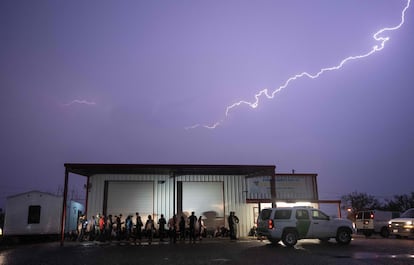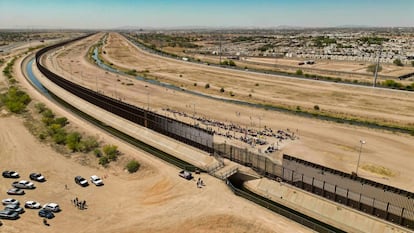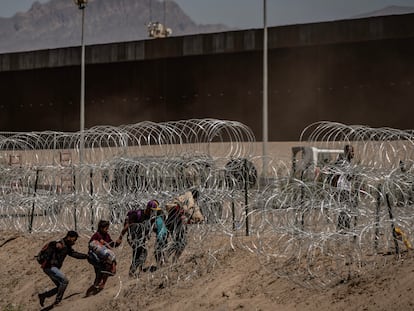Immigration rules in the United States: Examining a ‘broken system’
The latest crisis on the Mexican border has shone light on a problem that dates back decades. Judges are overwhelmed and Congress, more polarized than ever, is incapable of providing solutions

It’s an argument made by U.S. Secretary of Homeland Security, Alejandro Mayorkas, immigration activists working on the ground and Oscar Leeser, the major of El Paso, the U.S. city most affected by the border crisis. Even some Republicans agree: the U.S. immigration system is “broken.”
This claim — which is used as both an excuse and as an attack — highlights an old debate that was revived last week with the images of thousands of migrants desperately knocking on the southern door of the United States.
The latest attempt to fix the U.S. immigration system came Thursday with the end of Title 42 — a sanitary measure imposed by Donald Trump in 2020 — which resulted in more than 2.8 million fast-tracked deportations in 40 months, and opened a new era in migratory relations with Mexico. To replace this norm, the Joe Biden administration has approved a program to reinforce the old Title 8. This updated policy toughens the conditions to request asylum: under the new rules, migrants who are deported may not attempt to enter the U.S. for another five years.
Washington’s idea is to “expand lawful pathways for protection.” Of the announced measures, notable changes include calling on migrants to schedule an appointment to present themselves at a port of entry via a cellphone application, the opening of hundreds of regional processing centers (RPCs) and an agreement with Spain and Canada to take in approved asylum seekers.
In presenting his plan, Mayorkas blamed Congress for the latest immigration crisis, which has been worsening since last fall, reaching a peak last week, with more than 11,000 daily arrests. According to Mayorkas, the current situation “is the outcome of Congress leaving a broken, outdated immigration system in place for over two decades, despite unanimous agreement that we desperately need legislative reform.” He added: “It is also the result of Congress’s decision not to provide us with the resources we need and that we requested.”
Many of the migrants wandering the streets of El Paso last week had been given paperwork that allowed them to move freely around the United States. They are the definitive proof that something is not working in the U.S. immigration system. These migrant had begun the process to request asylum and were given Notice to Appear (NTA) documents: the official document that instructs an individual to appear before an immigration judge. Venezuelan migrant Exel Pérez, for example, was given a notice to appear for the end of 2025 in New York. And it is by no means the longest waiting period: the average time frame for court hearings is more than four years, while in some cases it is up to 10 years.

“That means many never appear in court,” says Blake Barrow, director of the Rescue Mission of El Paso shelter, which has a capacity for about 200 migrants. “They stay in the United States, keeping quiet, and if they don’t commit any crimes, they may never be deported. They end up slipping through the cracks of the system.” Only 18% of asylum seekers who begin the asylum process appear at their court dates, according to data from the first quarter of 2023, compiled by the Justice Department.
The waiting periods are so long because all the cases fall on some 650 demoralized judges spread across 68 courts and three adjudication centers in the United States. These magistrates are in charge of reviewing half of all pending asylum applications, while the other half are reviewed by officials from the U.S. Citizenship and Immigration Services. According to Syracuse University, nearly 1.6 million asyslum applications were pending in 2023, the largest number in history. And this record is likely to be broken by the end of 2023.
“There is a shortage of judges and a shortage of asylum officers,” Andrew Selee, president of the Washington-based nonpartisan Migration Policy Institute, said Friday in a telephone interview. Selee — who believes that the U.S. southern border has been “more porous than desirable” under Title 42 — does not expect much from the Capitol. “They are incapable of legislating on what is important. They only agree on harmless issues, like infrastructure packages,” he said. “This is due to the enormous polarization that dominates everything. It is still paradoxical: Americans see immigration more positively than 10 years ago, but the ideological confrontation neutralizes that positive feeling.”
Will Biden’s latest measures help? “They’re a good starting point, but they won’t fix the problem,” Selee said. “Maybe they will get the numbers down. And that is dangerous: it will appear like the problem has been solved, but people in their home countries will still feel they have no choice and start coming back.”
The legislative inaction in Washington is not exactly new. The last major law on the subject was approved in 1986 when Ronald Reagan was in the White House. The Republican leader — who was formerly the governor of the border state of California — deported 3.5 million people between 1985 and 1987, but also gave legal status to three million undocumented migrants, a third of whom were farmworkers. Four years later, George Bush Sr. passed a less far-reaching immigration bill.
In other words, the mechanisms of contemporary migration — which, accoding to experts, have been greatly influenced by the Covd-19 pandemic, greater access to technology and the rise of social media — are still governed by texts conceived when the internet didn’t even exist, climate change was not pushing people to leave their homes and the U.S. population was not aging.
The last attempt at an ambitious reform was made by Barack Obama, whose penchant for deportation earned him the nickname deporter-in-chief. Under his governments, there was a rise in arrests of undocumented immigrants who had been in the country for several years, sometimes even decades. His immigration reform was never approved, but in 2013, it was supported by 68 senators from both the Republican and Democratic Party.
Trump’s influence
Today, such support would be unthinkable. Why? The answer lies with Donald Trump. The former U.S. president’s anti-immigration rhetoric resonated with large sections of the white population, whose opposition to immigration was fueled by an explosive mix of anger and fear. This pushed the moderate wing of the Republican Party to take extreme positions on the issue. Republicans relentlessly attack Biden for “opening the border” to criminals and fentanyl traffickers. Immigration promises to be one of the main issues of the 2024 presidential elections.

With his racist rhetoric, Trump also managed to make the world believe that he was responsible for building the 700-mile wall along the 2,000-mile border stretching between the United States and Mexico. In reality, it was a collective effort, which was started Bill Clinton, who erected a wall between San Diego and El Paso. An immigration agent named John, who has been patrolling the 267-mile-stretch between Texas and Arizona for 24 years, says that wall has been strengthened over time. “It is getting higher and higher, and the materials are better,” he explained.
Like all his predecessors since Reagan, Biden also campaigned for president with big promises to address the immigration problem — a message that reached Latino voters. In his first week in office, he announced his intention to regularize millions of undocumented immigrants. But it’s not just Republican opposition that has prevented him from taking action. While he began his term by signing three decrees to reverse Trump’s executive orders, he has preferred to avoid the thorny issue in his more than two years in office. It’s an issue that doesn’t sit well even with Democrats, who continue to try to square the circle i.e. humanize immigration management while showing a strong hand. Mayorkas defined this conundrum well: “we are a nation of immigrants, and we are a nation of laws.”
Biden’s biggest contribution to the border debate has been to end Title 42, and strengthen Title 8. But this move has received criticisms from both sides of the debate: for some, it is too soft, for others, like activist Mónica Ramírez, it is too harsh. “The Biden administration constantly asks immigrants to use legal pathways, but those who seek to reach the United States lack the tools to understand how to navigate those pathways,” Ramírez, the president of the NGO Justice for Migrant Women, explained in an email. “[Biden’s policies] focus too much on creating ways for migrants to integrate into the workforce, without allowing them to become citizens. In addition, this design has traditionally favored men, which has contributed to the rise of the percentage of undocumented women. The immigration system is broken from the start, because it was never designed to favor the most vulnerable.”
The immigration problem dates back to at least the presidency of Dwight Eisenhower (1953-1961), who deported 1.8 million immigrants as part of Operation Wetback, a sweeping deportation campaign named after a derogatory term for foreign nationals, most commonly Mexicans.
For Oscar Leeser, the Democratic mayor of El Paso, the key to solving the crisis is cooperation. “Congress has to find a way to reach an understanding. Because this is a national problem, not just a problem for the four border states. It would be a good idea to improve collaboration with countries of origin and streamline procedures, especially those for obtaining the work permit. They [migrants] come to our streets wanting to earn money in a decent way, why not let them?”
For Selee, it’s just a question of simple math: “On the one hand, we have a huge shortage of workers and the legal ways to enter the country are clearly not up to those needs. It is an economic matter, but also a demographic one: the American population is a rapidly aging population.”
Sign up for our weekly newsletter to get more English-language news coverage from EL PAÍS USA Edition
Tu suscripción se está usando en otro dispositivo
¿Quieres añadir otro usuario a tu suscripción?
Si continúas leyendo en este dispositivo, no se podrá leer en el otro.
FlechaTu suscripción se está usando en otro dispositivo y solo puedes acceder a EL PAÍS desde un dispositivo a la vez.
Si quieres compartir tu cuenta, cambia tu suscripción a la modalidad Premium, así podrás añadir otro usuario. Cada uno accederá con su propia cuenta de email, lo que os permitirá personalizar vuestra experiencia en EL PAÍS.
¿Tienes una suscripción de empresa? Accede aquí para contratar más cuentas.
En el caso de no saber quién está usando tu cuenta, te recomendamos cambiar tu contraseña aquí.
Si decides continuar compartiendo tu cuenta, este mensaje se mostrará en tu dispositivo y en el de la otra persona que está usando tu cuenta de forma indefinida, afectando a tu experiencia de lectura. Puedes consultar aquí los términos y condiciones de la suscripción digital.
More information
Archived In
Últimas noticias
Welcome to the post-religion era: The idea of Christianity as the absolute truth has become obsolete
‘I thought you would like it’: The risky sexual practice popularized by TV shows and TikTok
The digitalization of tourism: ‘They promise experiences and gave us the worst possible one’
Mexican peso defies uncertainty with forecasts of a new period of stability in 2026
Most viewed
- Sinaloa Cartel war is taking its toll on Los Chapitos
- Reinhard Genzel, Nobel laureate in physics: ‘One-minute videos will never give you the truth’
- Oona Chaplin: ‘I told James Cameron that I was living in a treehouse and starting a permaculture project with a friend’
- Why the price of coffee has skyrocketed: from Brazilian plantations to specialty coffee houses
- Silver prices are going crazy: This is what’s fueling the rally










































